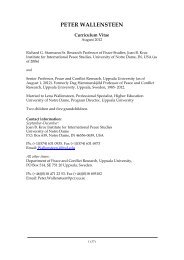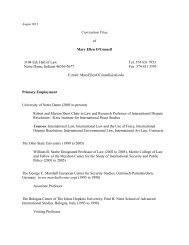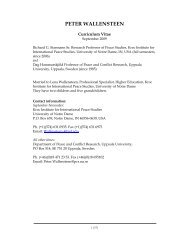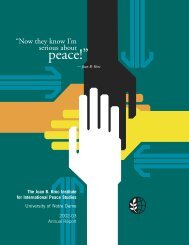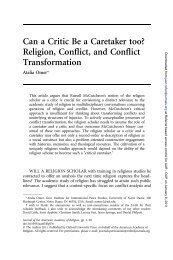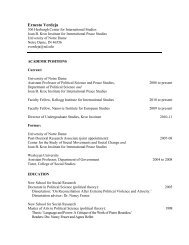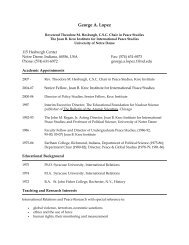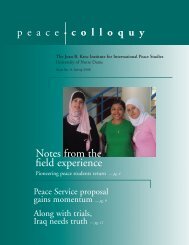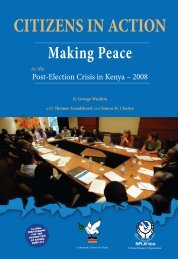Somalia: Creating Space for Fresh Approaches to Peacebuilding
Somalia: Creating Space for Fresh Approaches to Peacebuilding
Somalia: Creating Space for Fresh Approaches to Peacebuilding
Create successful ePaper yourself
Turn your PDF publications into a flip-book with our unique Google optimized e-Paper software.
jessica brandwein<br />
9 Hammond, “Framing Post<br />
Cold-War Conflicts”: p. 6.<br />
10 According <strong>to</strong> John Paul<br />
Lederach, conflict trans<strong>for</strong>mation<br />
“proposes an ef<strong>for</strong>t <strong>to</strong> maximize<br />
the achievement of constructive,<br />
mutually beneficial processes<br />
and outcomes [of a conflict].”<br />
(Lederach, John Paul, Preparing<br />
<strong>for</strong> Peace: Conflict Trans<strong>for</strong>mation<br />
Across Cultures, (Syracuse, NY:<br />
Syracuse University Press, 1995),<br />
19).<br />
11 Galtung, Johan, “High Road,<br />
Low Road: Charting the Course<br />
<strong>for</strong> Peace Journalism”, Track Two,<br />
7, 4 (1998): p. 3.<br />
12 Shinar, Dov, “Why Not More<br />
Peace Journalism? The Coverage<br />
of the 2006 Lebanon War in<br />
Canadian and Israeli Media,”<br />
Peace Journalism in Times of War,<br />
ed. Susan Dente Ross and Majid<br />
Tehranian, New Brunswick, NJ:<br />
Transaction Publishers, 2009):<br />
p. 9.<br />
13 Jakobsen, Peter, “Focus on<br />
the CNN Effect Misses the Point:<br />
The Real Media Impact on<br />
Conflict Management is Invisible<br />
and Indirect”, Journal of Peace<br />
Research, 37, 2 (2000): p. 138.<br />
54<br />
The emphasis that the media puts on certain aspects of the conflict over others<br />
influences our understanding of the situation, and implicitly proposes specific<br />
solutions over others. For example, internal conflicts can be framed in a variety<br />
of ways, including as civil wars, genocides, ethnic conflicts or humanitarian<br />
crises, each of which implies certain assumptions about the causes of the conflict<br />
and the responsibilities of the international community. Suggesting that an<br />
internal conflict is an “ethnic conflict” often implies <strong>to</strong> readers that there is a<br />
reified division between the warring groups based on primordial identities. In<br />
this case, intervention may be viewed as futile, as it will not change the underlying<br />
ethnic identities that perpetuated the conflict. On the other hand, framing<br />
that same conflict as a genocide or a humanitarian crisis suggests that intervention<br />
is both legitimate and potentially legally or morally mandated <strong>to</strong> s<strong>to</strong>p the<br />
unnecessary suffering of the innocent. 9<br />
Peace journalism<br />
Peace journalism refers <strong>to</strong> Johan Galtung’s theory that the media should move<br />
beyond its focus on polarizing descriptions of war and violence <strong>to</strong> instead emphasize<br />
conflict trans<strong>for</strong>mation. 10 With regards <strong>to</strong> the media, war journalism uses<br />
a zero-sum analysis of violence that villainises one or both sides of the fighting,<br />
while peace journalism seeks <strong>to</strong> “depolarize by showing the black and white of all<br />
sides, and <strong>to</strong> deescalate by highlighting peace and conflict resolution as much as<br />
violence”. 11 This dynamic of war journalism is particularly evident in the coverage<br />
of the warring parties in <strong>Somalia</strong>. Specifically, the consistent negative framing of<br />
al-Shabaab in much of the media is at odds with a peace journalism approach,<br />
which would provide a more nuanced view of the organization, emphasizing<br />
potential avenues <strong>for</strong> engagement with it.<br />
In addition <strong>to</strong> providing depolarizing and nuanced coverage of the warring<br />
parties, peace journalism may highlight challenges faced by ongoing peace processes,<br />
potentially even offering solutions or areas of common ground that have<br />
been downplayed in national dialogues. It also involves focusing on the pre- and<br />
post-violence phases of conflict, emphasizing preventive and long-term peacebuilding<br />
opportunities. 12<br />
Generally, the media does a relatively poor job at attaining the standards of<br />
peace journalism, particularly the desired focus on pre- and post-violence. In the<br />
era of 24-hour media coverage, outlets strive <strong>for</strong> the most sensational s<strong>to</strong>ry that<br />
will sell newspapers and pull in viewers. These s<strong>to</strong>ries tend <strong>to</strong> be those of violence<br />
and suffering more so than recovery from violence or peacebuilding ef<strong>for</strong>ts.<br />
“Media focus on humanitarian suffering in the violence phase has contributed <strong>to</strong><br />
a channeling of funds from long-term development projects aimed at preventing<br />
conflict … <strong>to</strong> short-term emergency relief.” 13 Furthermore, the continuous portrayal<br />
of negative frames focused on violence and suffering lends the impression that<br />
the conflict is intractable, making it less likely that there will be <strong>for</strong>eign political<br />
support <strong>for</strong> either international or local peacebuilding activities. In this lens,<br />
international media should be analyzed not only according <strong>to</strong> its negative frames




